Recent studies indicate that the uneven melting of the Arctic and Antarctic ice sheets could significantly disrupt the global climate system. This research, published in Science on August 1, reveals that the accelerated and asynchronous melting of these polar ice sheets is likely to disturb the global climate, with far-reaching consequences.
Historical Insights on Polar Ice Sheets Melting
Moreover, research led by geologists and climate scientists from the Chinese Academy of Sciences Institute of Earth Environment focuses on a critical climate transition event that occurred around a million years ago. This event, known as the Mid-Pleistocene Transition, altered Earth’s glacial cycles from 41,000 years to 100,000 years. Significantly, the study highlights how the asynchronous growth of the Antarctic and Arctic ice sheets played a crucial role in this transition.
Key Discoveries and Their Implications
A team of 28 researchers from institutes in China, Germany, Australia, the United States, and Britain examined historical climate records. They discovered that between 1.25 and 2 million years ago, the expansion of the Antarctic ice sheet led to cooling in the northern high latitudes. Consequently, this cooling increased moisture transport to the northern hemisphere, leading to the rapid growth of the northern ice sheet. As a result, this sequence of events potentially triggered the Mid-Pleistocene Transition.
Through model simulations, the researchers reconstructed changes in hemispheric ice volume and tracked their progression. Ultimately, the findings suggest that the growth of the Antarctic ice sheet preceded that of the Arctic, making it a precursor to the Mid-Pleistocene Transition.
Modern Implications of Polar Ice Sheets Melting
The rapid melting of today’s polar ice sheets, especially in the Northern Hemisphere, could trigger another major climate event. The study, therefore, underscores the complex dynamic links between Earth’s polar ice sheets and their global effects. Furthermore, the disappearance of these ice sheets poses numerous risks, including the loss of polar habitats, rising sea levels threatening coastal cities, the release of long-frozen pathogens, and even changes to Earth’s rotational speed.
The Risks and Limited Benefits
While melting Arctic ice could potentially ease navigation and reduce carbon emissions by decreasing reliance on Russia’s northern routes, the overall risks, however, far outweigh these benefits. Therefore, the melting of polar ice sheets underscores the urgent need to understand and mitigate global climate change.
Conclusion: Addressing the Urgent Challenge
In conclusion, this research underscores the importance of understanding the asynchronous development of hemispheric ice sheets to fully grasp global climate change. The findings highlight the critical need for immediate action to address the rapid melting of polar ice sheets and their profound implications for the global climate system.

